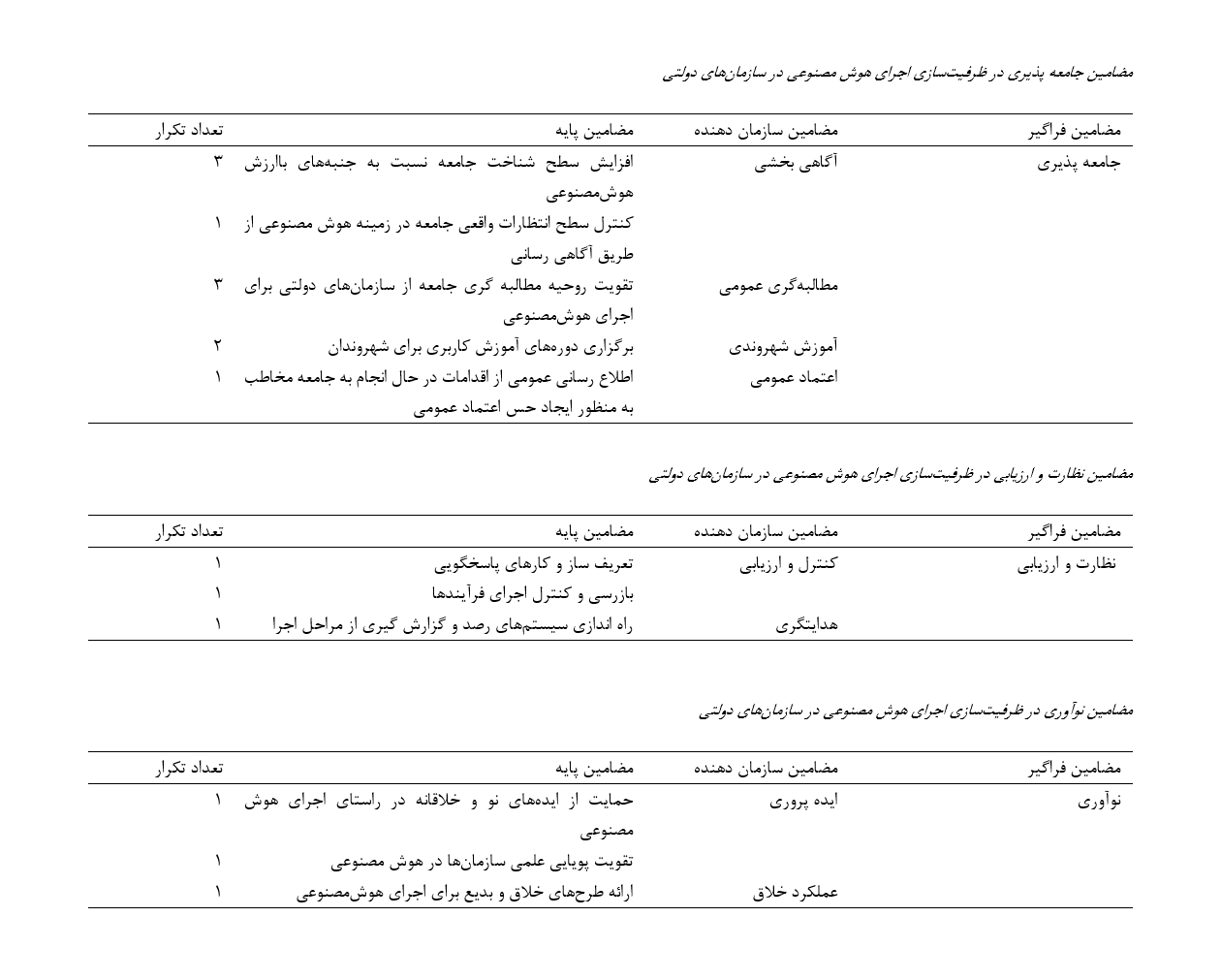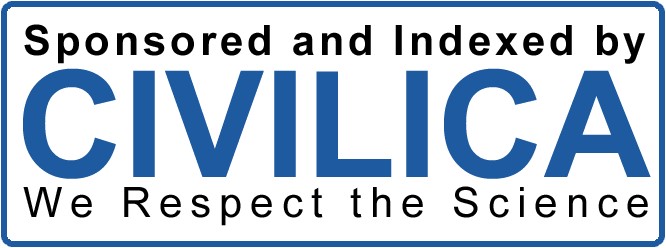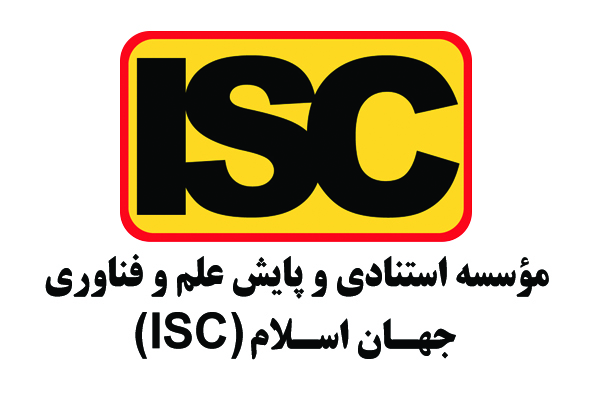ظرفیتسازی اجرای هوشمصنوعی در سازمانهای دولتی
کلمات کلیدی:
هوشمصنوعی, ظرفیتسازی, سازمان های دولتیچکیده
هوشمصنوعی به عنوان پدیده شگرف در سالهای اخیر، تحولی عظیم را در جهان ایجاد کرده و آن را به شرطی لازم برای توسعه و پیشرفت سازمانهای خصوصی و دولتی تبدیل نموده است. اجراء و پیاده سازی موفق هر طرح مستلزم ظرفیت سازی به منزله کشف نیازها، چالش ها، توانمندیها و تقویت سیستم در مسیر توسعه دارد. بر این اساس، هدف پژوهش شناسایی ظرفیتهای مورد نیاز برای اجرای هوشمصنوعی در سازمانهای دولتی و ارائه مدلی جامع برای آن است که با روش کیفی بر اساس گرندد تئوری، 15 نفر از نخبگان دانشگاهی و مدیران دستگاههای دولتی با روش گلوله برفی انتخاب و طی مصاحبه نیمهساختاریافته به سوالات پژوهش پاسخ دادند. در تحلیل داده ها با شیوه تحلیل مضمون و کدگذاری باز، 10 مضمون فراگیر، 36 مضمون سازمان دهنده و 66 مضمون پایه با تکرارشوندگی متنوع کشف شد. با توجه به یافته های پژوهش، اجرای موثر و موفق هوشمصنوعی در سازمانهای دولتی مستلزم توجه و اقدام در تامین منابع و امکانات، سیاستگذاری و برنامهریزی، مدیریت دادهها، تقویت حوزه منابعانسانی، تعاملات میان سازمانی، اراده حاکمیتی، تقویت فرهنگسازمانی، جامعه پذیری، نظارت و ارزیابی و نوآوری است که هر یک از این موارد شامل مضامینی سازماندهنده و پایهای برای اجراء هستند. در پایان مدل جامعی از ظرفیت سازی هوشمصنوعی، برای استفاده سازمانهای دولتی و مدیریت عمومی ارائه گردید.
دانلودها
مراجع
Allen, G. C. (2019). Understanding China's AI strategy: Clues to Chinese strategic thinking on artificial intelligence and
national security. http://www.globalhha.com/doclib/data/upload/doc_con/5e50c522eeb91.pdf
Andrews, M., Pritchett, L., & Woolcock, M. (2017). Building state capability: Evidence, analysis, action. Oxford
University Press. https://doi.org/10.1093/acprof:oso/9780198747482.001.0001
Azad News Agency, A. (2024). https://ana.ir/003tLA
Bailey, D. E., Faraj, S., Hinds, P. J., Leonardi, P. M., & von Krogh, G. (2022). We are all theorists of technology now:
A relational perspective on emerging technology and organizing. Organization Science, 33(1), 1-18.
https://doi.org/10.1287/orsc.2021.1562
Benbya, H., Davenport, T. H., & Pachidi, S. (2020). Artificial intelligence in organizations: Current state and future
opportunities. MIS Quarterly Executive, 19(4). https://doi.org/10.2139/ssrn.3741983
Campion, A., Gasco-Hernandez, M., Jankin Mikhaylov, S., & Esteve, M. (2022). Overcoming the challenges of
collaboratively adopting artificial intelligence in the public sector. Social Science Computer Review, 40(2), 462-477.
https://doi.org/10.1177/0894439320979953
Chen, Y. C., Ahn, M. J., & Wang, Y. F. (2023). Artificial intelligence and public values: value impacts and governance
in the public sector. Sustainability, 15(6), 4796. https://doi.org/10.3390/su15064796
Duan, Y., Edwards, J. S., & Dwivedi, Y. K. (2019). Artificial intelligence for decision making in the era of Big Dataevolution, challenges and research agenda. International Journal of Information Management, 48, 63-71.
https://doi.org/10.1016/j.ijinfomgt.2019.01.021
Gesk, T. S., & Leyer, M. (2022). Artificial intelligence in public services: When and why citizens accept its usage.
Government Information Quarterly, 39(3). https://doi.org/10.1016/j.giq.2022.101704
Goddard, M. A., Davies, Z. G., Guenat, S., Ferguson, M. J., Fisher, J. C., Akanni, A., & Dallimer, M. (2021). A global
horizon scan of the future impacts of robotics and autonomous systems on urban ecosystems. Nature ecology &
evolution, 5(2), 219-230. https://doi.org/10.1038/s41559-020-01358-z
Haque, M. S., Ramesh, M., Puppim de Oliveira, J. A., & Gomide, A. D. A. (2021). Building administrative capacity for
development: limits and prospects. International Review of Administrative Sciences, 87(2), 211-219.
https://doi.org/10.1177/00208523211002605
Ika, L., & Donnelly, J. (2019). Under What Circumstances Does Capacity Building Work? Capacity Building in
Developing and Emerging Countries: From Mindset Transformation to Promoting Entrepreneurship and Diaspora
Involvement, 43-90. https://doi.org/10.1007/978-3-030-16740-0_3
Kacou, K. P., Ika, L. A., & Munro, L. T. (2022). Fifty years of capacity building: Taking stock and moving research
forward. Public Administration and Development, 42(4), 215-232. https://doi.org/10.1002/pad.1993
Karamipour, M. (2023). Designing and explaining the model of artificial intelligence competencies on organizational
performance considering B2B marketing capabilities. Journal of value creating in Business Management, 3(2), 20-
https://www.jvcbm.ir/article_175599.html?lang=en
Kassens-Noor, E., Wilson, M., Kotval-Karamchandani, Z., Cai, M., & Decaminada, T. (2021). Living with autonomy:
Public perceptions of an AI-mediated future. Journal of Planning Education and Research.
https://doi.org/10.1177/0739456X20984529
Kolahi, M., AzimiSeginSara, R., & Hatami Yazd, A. (2022). Organization of Bazangan Wetland through Capacity
Building and Social Participation. Human & Environment, 20(4), 68-73.
Lee, M. C., Scheepers, H., Lui, A. K., & Ngai, E. W. (2023). The implementation of artificial intelligence in
organizations: A systematic literature review. Information & Management, 60(5).
https://doi.org/10.1016/j.im.2023.103816
Loper, A. C., Jensen, T. M., Farley, A. B., Morgan, J. D., & Metz, A. J. (2022). A systematic review of approaches for
continuous quality improvement capacity-building. Journal of Public Health Management and Practice, 28(2),
E354-E361. https://doi.org/10.1097/PHH.0000000000001412
Luo, X., Tong, S., Fang, Z., & Qu, Z. (2019). Frontiers: Machines vs. humans: The impact of artificial intelligence chatbot
disclosure on customer purchases. Marketing Science, 38(6), 937-947. https://doi.org/10.1287/mksc.2019.1192
Maragno, G., Tangi, L., Gastaldi, L., & Benedetti, M. (2023). Exploring the factors, affordances and constraints outlining
the implementation of Artificial Intelligence in public sector organizations. International Journal of Information
Management, 73. https://doi.org/10.1016/j.ijinfomgt.2023.102686
Mbangula, D. K. (2025). Exploring the Integration of ICT in Public Sector Management in Namibia. In Encyclopedia of
Information Science and Technology, Sixth Edition. IGI Global. https://doi.org/10.4018/978-1-6684-7366-5.ch039
Mikalef, P., Lemmer, K., Schaefer, C., Ylinen, M., Fjørtoft, S. O., Torvatn, H. Y., Gupta, M., & Niehaves, B. (2022).
Enabling AI capabilities in government agencies: A study of determinants for European municipalities. Government
Information Quarterly, 39(4), 101596. https://www.sciencedirect.com/science/article/pii/S0740624X21000320
Mikhaylov, S. J., Esteve, M., & Campion, A. (2018). Artificial intelligence for the public sector: opportunities and
challenges of cross-sector collaboration. Philosophical transactions of the royal society a: mathematical, physical
and engineering sciences, 376(2128). https://doi.org/10.1098/rsta.2017.0357
Mupaikwa, E. (2025). The Application of Artificial Intelligence and Machine Learning in Academic Libraries. In
Encyclopedia of Information Science and Technology, Sixth Edition. IGI Global. https://doi.org/10.4018/978-1-
-7366-5.ch041
Neumann, O., Guirguis, K., & Steiner, R. (2024). Exploring artificial intelligence adoption in public organizations: a
comparative case study. Public Management Review, 26(1), 136-1541.
https://doi.org/10.1080/14719037.2022.2048685
Nortje, M. A., & Grobbelaar, S. S. (2020). A framework for the implementation of artificial intelligence in business
enterprises: A readiness model. 2020 IEEE International Conference on Engineering, Technology and Innovation
(ICE/ITMC),
Pedro, R. (2023). Artificial intelligence on public sector in Portugal: first legal approach. Juridical Trib., 13, 149.
https://doi.org/10.24818/TBJ/2023/13/2.01
Pires, M. (2024). Artificial Intelligence (AI) in the field of Tax Administration. Review of International and European
Economic Law, 3(5). https://www.rieel.com/index.php/rieel/article/view/90
Purbokusumo, Y., Katangga, B., Lele, G., & Kumorotomo, W. (2021). Electronic Government (e-Gov), Artificial
Intelligence (AI), dan Kesenjangan Digital Tinjauan Studi Manajemen dan Kebijakan Publik di Indonesia. Gadjah
Mada University Press.
Rafiean, M., Khodaee, Z., & Dadashpoor, H. (2014). Community capacity building as an approach in empowering social
institutions. Sociology of Social Institutions, 1(2), 133-160. https://ssi.journals.umz.ac.ir/article_735.html?lang=en
Reim, W., Åström, J., & Eriksson, O. (2020). Implementation of artificial intelligence (AI): a roadmap for business model
innovation. Ai, 1(2), 11. https://doi.org/10.3390/ai1020011
Ricks, J. I., & Doner, R. F. (2021). Getting institutions right: Matching institutional capacities to developmental tasks.
World Development, 139. https://doi.org/10.1016/j.worlddev.2020.105334
Rowshan, S. A., Yaqoubi, N., & Momeni, A. (2021). Application of artificial intelligence in the public sector (metacombination study). Iranian journal of management sciences, 16(61), 117-145.
https://journal.iams.ir/article_349.html?lang=en
Schaefer, C., Lemmer, K., Samy Kret, K., Ylinen, M., Mikalef, P., & Niehaves, B. (2021). Truth or dare?-how can we
influence the adoption of artificial intelligence in municipalities?
Simaei Chaffi, H., & Memarzadeh Tehran, G. (2022). A Model for Capacity Building in Network Governance.
Management and Development Process, 35(1), 25-60. https://doi.org/10.52547/jmdp.35.1.25
Van Noordt, C., & Misuraca, G. (2022). Artificial intelligence for the public sector: results of landscaping the use of AI
in government across the European Union. Government Information Quarterly, 39(3).
https://doi.org/10.1016/j.giq.2022.101714
Weber, M., Engert, M., Schaffer, N., Weking, J., & Krcmar, H. (2023). Organizational capabilities for ai implementationcoping with inscrutability and data dependency in ai. Information Systems Frontiers, 25(4), 1549-1569.
https://doi.org/10.1007/s10796-022-10297-y
Wirtz, B. W., Weyerer, J. C., & Geyer, C. (2019). Artificial intelligence and the public sector-applications and challenges.
International Journal of Public Administration, 42(7), 596-615. https://doi.org/10.1080/01900692.2018.1498103
Wisniewski, H. S. (2020). What is the Business with AI? Preparing Future Decision Makers and Leaders. Technology &
Innovation, 21(4), 15-36. https://doi.org/10.21300/21.4.2020.4
Wodeki, B. (2023). Iran Vies to Become Top 10 AI Nation by 2032. https://aibusiness.com/verticals/iran-vies-tobecome-top-10-ai-nation-by-2032#close-modal
Yigitcanlar, T., Corchado, J. M., Mehmood, R., Li, R. Y. M., Mossberger, K., & Desouza, K. (2021). Responsible urban
innovation with local government artificial intelligence (AI): A conceptual framework and research agenda. Journal
of Open Innovation: Technology, Market, and Complexity, 7(1), 71. https://doi.org/10.3390/joitmc7010071

دانلود
چاپ شده
ارسال
بازنگری
پذیرش
شماره
نوع مقاله
مجوز
حق نشر 2024 تکنولوژی در کارآفرینی و مدیریت استراتژیک

این پروژه تحت مجوز بین المللی Creative Commons Attribution-NonCommercial 4.0 می باشد.










